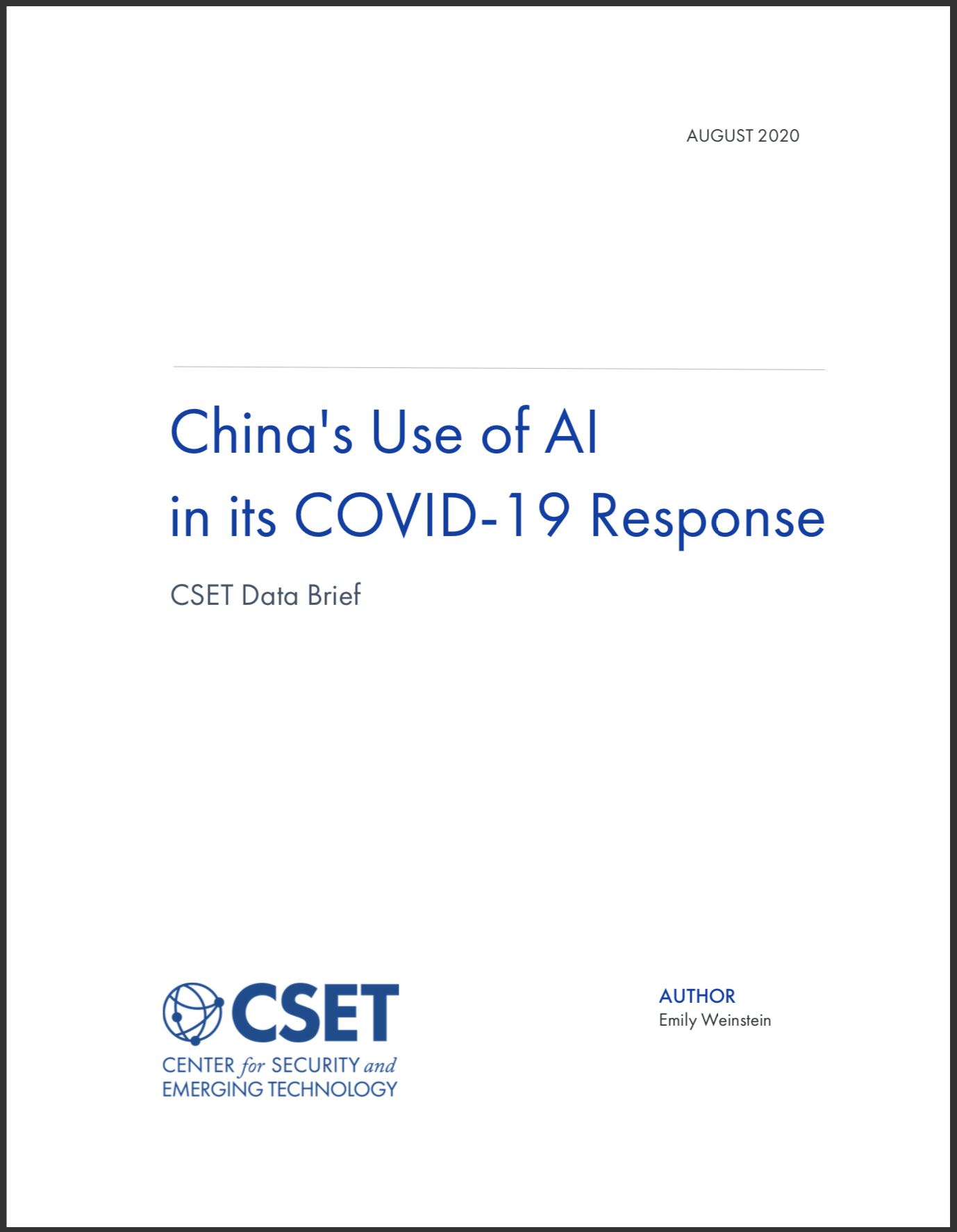Xi Jinping has made artificial intelligence a primary focus of China’s innovation and high-tech development since 2012. Policies released under his leadership touch on various aspects of AI, from military applications to manufacturing, ecological preservation, and healthcare. High-level guiding policies like the 2017 “Next Generation Artificial Intelligence Development Plan” (新一代人工智能发展规划) call for increased AI usage in the development of intelligent medical care and health and elder care systems.1
The emergence of COVID-19 in December 2019 has amplified these efforts, as Chinese companies of all sizes across AI-related sectors have developed and retooled AI systems for epidemic control and prevention. The State Council’s June 2020 White Paper, entitled “Fighting COVID-19: China in Action,” states that China has “fully utilized” artificial intelligence to not only research, analyze, and forecast COVID-19 trends and developments, but also to track infected persons, identify risk groups, and facilitate the resumption of normal business operations.2
This CSET data brief summarizes findings from a March 2020 report entitled “Example Applications of Digital Health Technology for Epidemic Prevention and Control (Third Phase)” (数字健康技术病情防空应用案例集(第三期)), published by the China Academy of Information and Communication Technology (中国信息通信研究院; 中国信通院; CAICT)—a think tank under the PRC’s Ministry of Industry and Information Technology (工业和信息化部; MIIT). The CAICT paper is a compilation of selected news reports from WeChat and official Chinese state-run media sources, company press releases, and academic journals highlighted by CAICT’s Center for Research on Medical and Health Big Data and Networks (医疗健康大数据和网络研究中心) for their contributions during the COVID-19 outbreak. This issue brief offers a high-level assessment of the types of AI technologies used to fight COVID-19 and the key players involved in this industry, according to CAICT assessments.
The tools and systems described in the CAICT report appear to address technological and logistical pandemic response challenges, including difficulties in case-by-case investigation, prevention, and control for “grassroots” case investigators;3 patient rehabilitation tracking and management;4 tracing close contacts of sick individuals; epidemic-related misinformation; medication consumption problems; supply mismanagement; and overworked doctors and understaffed hospitals.
Key findings from this analysis include the following:
- The artificial intelligence work described in the CAICT report spans across several AI-related fields, including surveillance, medical imaging, robotics, and human-computer interaction.
- Companies included in the CAICT report range from large-scale, state-owned enterprises to newer, smaller firms. Both types of companies receive similar praise for their efforts in epidemic prevention.
- In addition to prioritizing AI in hospital and medical settings, China is working to incorporate AI healthcare tools into business and everyday life as a means to find safe solutions for returning to full functionality in the post-COVID-19 era.
- Most AI-related epidemic prevention and control work highlighted in the CAICT report takes place in larger cities—primarily in Wuhan, where the outbreak emerged.
- Three highlighted companies are on the U.S. Department of Commerce Bureau of Industry and Security’s (BIS) Entity List: Yitu Technology, CloudMinds, and iFlytek.
This brief focuses on a section of the CAICT report examining use cases of artificial intelligence combating COVID-19. It presents an analysis of the technologies highlighted under five categories: surveillance, public health monitoring, medical imaging, robotics, and human-computer interaction, explored in depth below. These categories were chosen based on an assessment of the technologies presented by CAICT. It also examines the underlying commercial ecosystem.
Download full data brief
China’s Use of AI in its COVID-19 Response- “Notice of the State Council on Issuing the Next Generation Artificial Intelligence Development Plan” [国务院关于印发新一代人工智能发展规划的通知], State Council of the People’s Republic of China, July 2017, https://archive.vn/KmmxR.
- “Full Text: Fighting COVID-19: China in Action,” Xinhua News via the State Council, June 7, 2020, https://archive.vn/NYJQg.
- In this context, the author interprets “grassroots” to refer to local government and medical officials.
- Example Applications of Digital Health Technology for Epidemic Prevention and Control (Third Phase) [数字健康技术病情防空应用案例集(第三期)], Center for Research on Medical and Health Big Data and Networks [医疗健康大数据和网络研究中心] at the China Academy of Information and Communications Technology (中国信息通信研究院), March 24, 2020, https://cset.georgetown.edu/wp-content/uploads/t0124_CAICT_digital_tech_disease_prevention_EN.pdf.
